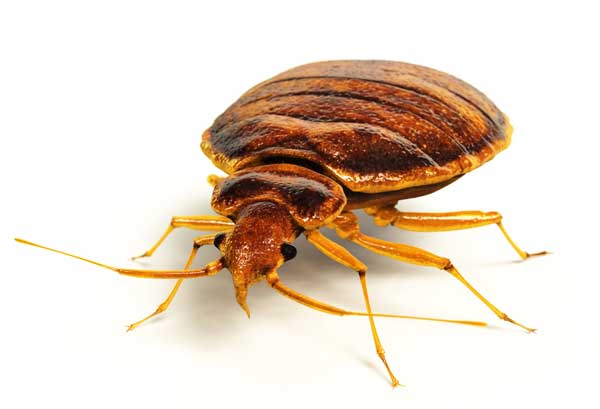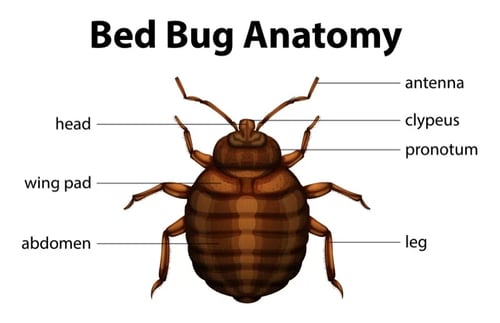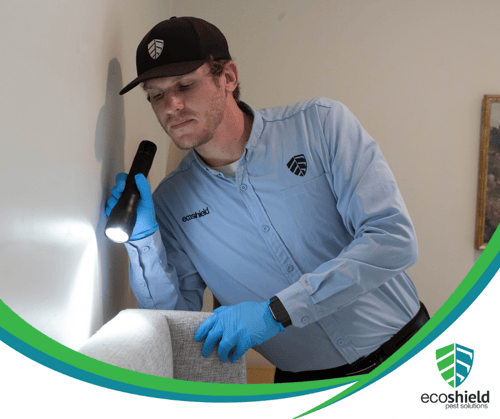
BED BUG CONTROL AND EXTERMINATION SERVICES IN DETROIT, MICHIGAN
If you are currently experiencing bed bugs in Detroit, MI, please call EcoShield today for a FREE No-Obligation estimate. Our Bed Bug Shield service is guaranteed to eliminate bed bugs from your home.
Bed bugs are one of the worst infestations you can have. These pesky pests feed on blood and can live up to a year without a meal. They reproduce quickly and hide away for so long that by the time you notice you’re infested, the infestation could be at a very high level.
EcoShield Pest Solutions can eliminate your bed bug problem and prevent further infestations in your home. Our experts are trained to effectively remove bed bugs from your home without endangering your family or pets. If you have any signs of a bed bug infestation, please call now since it will get progressively worse over time and DIY solutions are ineffective against bed bugs.
Schedule a FREE Estimate
What are bed bugs?
Bed bugs are small, parasitic insects that belong to the family Cimicidae, with the most common species being Cimex lectularius. These pests are notorious for feeding on human blood, typically at night, and have been a persistent nuisance for centuries. Measuring about 4-5 millimeters in length as adults, bed bugs are reddish-brown, oval-shaped, and wingless, with flat bodies that allow them to hide in tiny crevices. After feeding, their bodies swell and take on a darker, more engorged appearance. Their ability to survive without a blood meal for months, combined with their rapid reproduction rates, makes them particularly challenging to eradicate once they infest a space.

Bed bugs are not known to transmit diseases to humans, but their bites can cause significant discomfort. The bites often appear as small, red, itchy welts, sometimes in a line or cluster, as the bugs feed multiple times in one area. Reactions to bites vary widely—some people experience intense itching or allergic responses, while others may not notice the bites at all. Beyond the physical irritation, bed bugs can also take a psychological toll, leading to stress, anxiety, and sleep deprivation for those dealing with an infestation. They are most commonly found in places where people sleep, such as mattresses, box springs, headboards, and furniture, but they can also spread to clothing, luggage, and other personal items, making them adept hitchhikers.
The life cycle of a bed bug consists of five nymphal stages before reaching adulthood, with each stage requiring a blood meal to molt and progress. Females can lay hundreds of eggs in their lifetime—tiny, white, and about the size of a pinhead—often depositing them in hidden spots like seams, cracks, or folds of fabric. This reproductive efficiency, paired with their resilience to many common pesticides, has led to a global resurgence of bed bug infestations in recent decades. Factors like increased travel, secondhand furniture use, and resistance to insecticides have fueled their comeback, turning them into a modern pest control challenge.
Historically, bed bugs were nearly eradicated in developed countries mid-20th century thanks to potent chemicals like DDT. However, bans on such harsh pesticides and evolving resistance have allowed their populations to rebound. Today, managing an infestation often requires a combination of methods: freezing/heat treatments, vacuuming, encasements for mattresses, and targeted pesticide applications by professionals. Prevention is key—regular inspection of sleeping areas, caution with used furniture, and protective measures while traveling can reduce the risk. While bed bugs don’t carry disease, their elusive nature and tenacity make them a formidable adversary in homes, hotels, and even public spaces worldwide.
Lifecycle
A bed bug’s life begins with an egg that is grain like and milky white in color. Female bed bugs lay between one and five eggs each day and may lie up to 500 eggs within one lifetime. Eggs are laid singly or in clusters and are placed within tight cracks or crevices. The egg is approximately 1 mm in length and is comparable in size to two grains of salt or a speck of dust. Within two weeks, the eggs hatch, and immature bed bugs begin immediately to feed.
Mature bedbugs are reddish brown in color, flattened, and wingless. The pests are oval-shaped and approximately 4-5 mm long and can run quickly. It’s color deepens to red-brown after dining on a blood meal. Usually the bed bugs are flat from top to bottom but will balloon up when filled with blood. Adults can live an average of up to 1 year and feed every 5 to 10 days. Eggs aren’t easily visible because of being cream colored and tiny (as in 1mm in length).
Since they do not have wings they cannot fly, but they do move quickly over floors, walls, and ceilings.
Feeding
The five nymphal instars (stages) must each take a blood meal to develop to the next stage. As the bed bugs continue to develop, they become larger and become darker until they reach adulthood. Adults have been reported to live 3-12 months in an untreated household situation.
A given undisturbed bug may take 3-15 minutes to take a full meal, depending on its life stage. Bed bugs can also survive prolonged periods of time without feeding, reappearing from their hiding places when hosts again become available.
Anatomy
Below is an illustration showing the parts of an adult bed bug’s body.

CAN I PREVENT BED BUGS? IF SO, HOW?
Bed bugs are the unwelcome houseguests nobody wants—tiny, sneaky, and relentless in their pursuit of a cozy spot in your home. The good news? Yes, you can absolutely take steps to prevent a bedbug infestation before it starts. While these pests are notoriously resilient and skilled at hitching rides on luggage, clothing, or used furniture, a combination of proactive habits and, when needed, professional help can keep them at bay. Let’s explore how you can protect your space and sleep soundly without those itchy bites.
Prevention begins with vigilance. When traveling, inspect hotel rooms by checking mattress seams, headboards, and upholstery for small reddish-brown bugs or dark spots (their droppings). Use a hard-sided suitcase and keep it off the floor or bed and consider packing clothes in sealed plastic bags. Over-the-counter bed bug monitors may also be useful when traveling. Once home, wash and dry your travel clothes on high heat—bed bugs can’t survive temperatures above 120°F. At home, reduce clutter where bed bugs might hide, and regularly vacuum mattresses, furniture, and baseboards. Encasing your mattress and box spring in bed bug-proof covers adds an extra layer of defense, trapping any potential invaders and making it harder for them to settle in. If you’re buying secondhand furniture, give it a thorough once-over before bringing it inside—those bargain finds can sometimes come with hidden passengers.
Sometimes, despite your best efforts, bed bugs still find a way in. That’s where professional pest control companies like EcoShield Pest Solutions come to the rescue. Experts in the field, they offer tailored strategies beyond DIY methods, using advanced treatments that are both effective and safe for your home. EcoShield can also conduct preventative inspections, especially if you suspect exposure—like after a trip or a neighbor’s infestation. Their trained technicians know exactly where bedbugs hide and how to stop them before they multiply. Combining your everyday diligence with the expertise of a company like EcoShield gives you the best shot at keeping your home bedbug-free, so you can rest easy without worrying about nighttime nibblers.
WHAT DO BED BUG BITES LOOK LIKE?
You will not see bed bugs living on your body. Unlike lice and the mites that cause scabies, bed bugs do not live on humans. Bed bugs come out of hiding to feed on human blood in order to survive, and the feeding lasts about 4 to 12 minutes. After a bedbug feeds, it returns to its hiding place.
The first time you are bitten, the bites may not itch right away. It can take time for your body to develop a reaction to the bites. Some people develop itchy welts within a few days of the first bites, but it can take as long as 14 days before the bites itch.

Some people also will not experience a reaction to a bed bug bite at all. Those that do experience symptoms of a bite are likely to experience one or more of the following:
-
a bite with a red, swollen area and a dark red center
-
bites in a line or grouped together in a small area
-
blisters or hives at the bite site
Bites can happen anywhere on the body. Most commonly, they occur on areas of skin that are exposed while sleeping, such as the face, arms, legs, and hands.
There are currently a couple of explanations for why bites often appear in rows:
The first theory is that they feed while you are sleeping and when you move or twitch and the bug will remove its mouthparts from your skin. When you stop moving the bug crawls a short distance and bites again; this can result in one bug leaving several bites in a row.
Another theory is that you lay on a crease in your sheets and there could be several bugs in that crease. As you lay there the bugs bite at the same time which leaves a row of bite marks.
Just because you have several bites, this does not dictate the number of bugs you have. The theories above just show ways in which you can have rows of bite marks.
Also, it is important to realize that medical professionals cannot give a positive diagnosis simply by examining bite symptoms, they can only suggest some possible explanations for what may have caused the bites/symptoms to occur.
CAN I TREAT A BED BUG INFESTATION MYSELF?
Discovering a bed bug infestation in your home can be a nightmare, and your first instinct might be to tackle it yourself. The good news? It’s possible to treat a bed bug problem on your own to some extent, especially if you catch it early. DIY methods can help reduce the population and give you a fighting chance, but they often fall short of completely eliminating these resilient pests. Bed bugs are notoriously tough— they hide in tiny crevices, reproduce quickly, and can survive months without a meal—so a determined approach is key if you’re going it alone.
For a DIY solution, start with thorough cleaning. Wash all bedding, curtains, and clothing in hot water (at least 120°F) and dry them on the highest heat setting for at least 30 minutes to kill any bugs or eggs. Vacuum your mattress, furniture, and baseboards meticulously, then seal the vacuum bag in a plastic bag and dispose of it immediately. You can also use diatomaceous earth, a natural powder that dehydrates bed bugs—sprinkle it in cracks, along baseboards, and around bed frames, leaving it for a few days before vacuuming it up. Steam cleaning is another option; a handheld steamer can kill bed bugs on contact if the temperature reaches 130°F or higher. These steps can make a dent, but they require persistence and precision.

That said, here’s the catch: DIY methods are rarely a complete fix for an active infestation. Bed bugs are masters of survival and missing even a few hiding spots can lead to a resurgence. That’s why, for peace of mind and guaranteed results, hiring a professional like EcoShield Pest Solutions is the smartest move. Experts have access to advanced tools—like temperature-controlled treatments and targeted insecticides—that go beyond what’s available to the average homeowner. They also know how to track down every last bug and egg, ensuring the problem doesn’t come back to bite (literally). So, while you can start with some DIY efforts, calling in the pros is the best way to reclaim your home from these unwelcome guests.
HOW MUCH DOES IT COST FOR PROFESSIONAL BED BUG REMOVAL?
When it comes to tackling a bed bug infestation, one of the first questions people ask is, “How much does it cost for professional bed bug removal?” The answer, like the little pests themselves, isn’t straightforward. Costs can vary widely depending on several factors, such as the size of your home, the severity of the infestation, and the specific treatment methods used. On average, homeowners might expect to pay anywhere from $300 to $3,000 for professional services, but in some cases, it could climb even higher—think $5,000 or more for large properties or stubborn infestations. It’s a range that can feel daunting, but understanding what drives the price can help you prepare.
The variation starts with the scope of the problem. A smaller home with a minor bed bug issue might only need a single treatment or pesticide application, keeping costs on the lower end. Meanwhile, a multi-story house with bed bugs infesting multiple rooms could require multiple visits and specialized equipment, pushing the bill up significantly. Then there’s the company you choose: some offer flat-rate packages, while others charge by the hour or square foot, and their expertise or reputation can influence the price tag.
Treatment type is another big factor. Some exterminators even combine methods for maximum effect, which can add to the cost but save you from repeat infestations. Ultimately, getting a few quotes from local pros is the best way to pin down what you’ll pay. Bed bugs don’t care about your budget, but with a little research, you can find a solution that balances effectiveness and affordability for your situation.
How do I choose the right bed bug removal company for me?
When it comes to choosing the right bed bug removal company, the process can feel overwhelming—after all, you’re dealing with an infestation that’s disrupting your peace of mind. The key is to focus on a few critical factors to ensure you’re hiring a reliable, effective service. Start by looking for a company with proven expertise and a track record of success. Check customer reviews and ask about their methods—do they use safe, modern techniques, or outdated approaches that might leave you with lingering problems? You’ll also want a team that offers transparency, like clear pricing and a detailed plan of action, so you’re not left guessing about what’s happening in your home.

The best option to consider is EcoShield Pest Solutions Bed Bug Shield service. Bed Bug Shield isn’t just about eliminating the problem today—it’s designed to protect your home long-term, using innovative treatments that target bed bugs at every life stage. Our trained technicians customize solutions to your specific situation, ensuring you’re not stuck with a one-size-fits-all approach. Plus, EcoShield emphasizes safe, family- and pet-friendly methods, so you can feel confident about the process. If you’re tired of the bites and sleepless nights, reaching out to EcoShield for their Bed Bug Shield service could be the smart, stress-free choice you need to reclaim your space.
BED BUG SHIELD SERVICE GUARANTEE
If your bugs come back in between regular visits, we will return and service for FREE. After two free re-services for the same guaranteed pest problem, if we don’t have your pests under control then we will credit 100% of your last full payment.
WHY CHOOSE ECOSHIELD FOR YOUR BED BUG SERVICE?
- We'll quickly eliminate bed bugs with the latest treatment technology
- The long lasting residual will keep your home protected
- Retreatment Guarantee: If the bedbugs come back we stand behind our work.
- Our annual customers enjoy year-round bedbug protection for their home.
- Bedbug monitoring devices are inspected and replaced if necessary
- We will retreat for any new infestations
- We'll repair or replace any damaged bedbug covers that were installed on the initial treatment
Learn more
For a free no-obligation quote, please give us a call or fill out the form on this page.